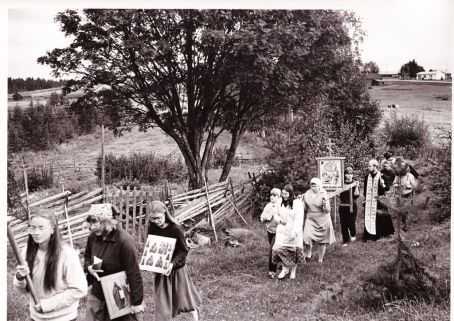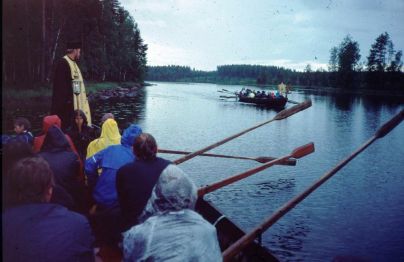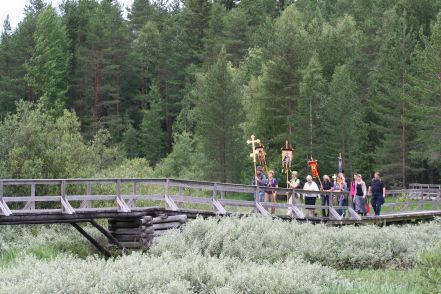Orthodox Procession of the Cross Tradition
| Orthodox Procession of the Cross Tradition | ||||
|---|---|---|---|---|
| In the national inventory | ||||
|

Practitioners and people who know the tradition well
The procession of the cross is an integral part of the life of the Orthodox Church. It is conducted everywhere in the Orthodox world and areas with ancient churches. This tradition is still very much alive in the Finnish Orthodox Church, which is celebrating the 100th anniversary of its autonomous status this year.
Shorter cross processions related to church celebrations, such as Easter, the Feast of the Baptism of Christ (Theophany), or temple feasts, are held in Finland hundreds of times each year. A parish or monastery always organizes these processions because the cross procession is a moving worship service in which a priest or clergy participates.
Parishes and monasteries in Finland also organize longer cross processions, lasting even for several days, covering long distances. Many of these are annual events and highly anticipated locally, often covered in local news. One of the most well-known is the cross procession of the icon of the Mother of God of Konevits, which takes place annually in early July from Valamo Monastery to Lintula Convent, involving both walking and boat travel.
Church organizations and individual priests can also organize cross processions. The idea of organizing a cross procession can also arise from the wishes of a local shrine community.
Although the cross procession is a distinctly Orthodox tradition, it has become familiar in recent decades as one of the most popular forms of ecumenical activity. Ecumenical cross processions have also made this tradition known in other Christian denominations.
The late Bishop Aleksi described the cross procession as a "devout demonstration." In this sense, the tradition of the cross procession has been utilized in recent years in various solidarity events. For example, after the outbreak of the war in Ukraine, cross processions were held in Helsinki in front of the Ukrainian embassy. Thus, the tradition of the cross procession has become familiar, especially in the Helsinki metropolitan area, to those who the basic activities of the churches may not necessarily reach.
Before the war in Ukraine, cross processions were also organized across the Russian border into the area of ceded Karelia. Such cross processions generated much interest
among parishioners and non-Orthodox individuals who became interested in their Orthodox roots through genealogical research.
Practising of the tradition
The cross procession is an ancient tradition of the church, in which the church's message is taken outside the church walls and into the world. It is a religious service in the Orthodox Church where a specific route is walked while carrying lit candles, the cross, church flags, the Gospel, and icons. Regardless of their religious affiliation, anyone can participate in a cross procession if they wish.
For example, during the first spring of the COVID-19 pandemic in 2020, the wonderworking icon of Mother of God Kozelshtshan was carried in a cross procession to the courtyards of Helsinki's largest hospitals and the Terhokoti hospice. Representatives of the parish conducted prayer services for those afflicted by illness. Outdoor cross processions were possible even when indoor activities were restricted, as people strongly needed to participate in communal prayer.
After the outbreak of the war in Ukraine, a large cross procession was organized in Helsinki on March 6, 2022. It started simultaneously from several different churches and stopped in front of the Ukrainian embassy to show support for Ukraine and pray for peace. The event, organized by the Helsinki Orthodox Parish, also attracted participants opposing the war in Ukraine.
A cross procession always begins from a church and eventually returns to the church. The actual journey can be quite short; for example, in Finland, the most well-known cross procession is the one conducted on Easter night, walking around the church building. However, cross processions can also last several days, covering hundreds of kilometers.
A cross procession can be a separate event or part of a church celebration or pilgrimage. Multiple cross processions can also be connected, with several starting points converging at the same destination.
Walking is the most common way to conduct a cross procession. In addition to walking, processions have been carried out by skiing, rowing, cycling, paddling, rollerblading, and various forms of public transportation, including trains, ships, and buses – even the metro. Only imagination sets the limits!
A cross procession can be physically demanding; for example, a service conducted on foot often lasts for hours before reaching the next resting place, which may be a house or a shrine. Thus, a cross procession reconciles spiritual and physical exercise, which is called spiritual struggle. However, the goal of Christian life is not to strain oneself physically but to achieve spiritual renewal and joy, guided by uninterrupted listening to holy texts and singing along. The church teaches that the cross procession purifies and nourishes the mind.
The cross procession is also a mobile congregation. The sacred procession conveys that Christians are strangers and pilgrims on earth. Christians journey through time toward the timeless and permanent. The cross procession serves as a guide for pilgrims. The cross, the sign of victory for Christians, leads the way. This signifies that a Christian must follow Christ and walk with Christ.

The background and history of the tradition
During the early days of the Church, especially during Christian persecutions, but also after they had ceased in the early 4th century, the Christian Church began to express its faith strongly through processions and parades outside the places of worship. Prayers and church chants accompanied these processions. Before the Easter Vigil, those who had been baptized would come to the sanctuary in a solemn procession to partake in the Holy Eucharist for the first time. This practice gave rise to the Easter night cross processions and the entire cross procession tradition we know today.
Shorter cross processions have always been a part of the life of the Orthodox Church throughout Finland. Still, the tradition of longer cross processions was strongest in the parishes that remained on the other side of the border during the war. The first decades after the war were a time of strong material reconstruction in the Finnish Orthodox Church. The period of reviving and passing on the intangible cultural heritage began immediately after this.
The tradition of long cross processions was revived in the early 1980s by traveling priest Vesa Takala. The processions he led involved carrying icons through the wilderness from town to town and from house to house. These processions could last up to a week. Father Vesa blessed homes, their occupants, animals, and the entire world along the way.
A bit later, cooperation between Finnish and Russian border authorities began to allow cross processions that crossed the national border. Before the war in Ukraine, a cross procession from Ilomantsi was conducted annually to Melaselkä on the Russian side, which was an old border village of Ilomantsi, and to the old Korpiselkä church village, where an old wooden Orthodox church still defies the passage of time. For many participants, these cross processions also served as pilgrimages to the old homesteads of their families, the ancestral churches, and cemeteries.
The rediscovered tradition of cross processions has only grown stronger over the past few decades. The renaissance that began in North Karelia has now reached all parishes, and cross processions are now considered diverse, flexible, and popular integral traditions of the Orthodox Church in Finland.
The transmission of the tradition
The tradition of cross processions is now passed down from one generation to another flexibly, much like other Christian traditions and customs.
In fact, the life of every Orthodox Christian is essentially a long cross procession. The Orthodox Church teaches that a person's entire life is a journey toward God. A newly baptized child takes their first cross procession by walking around the baptismal font three times. The final procession in a Christian's life is the funeral procession from the church to the cemetery.
A child or young person's first actual cross procession often occurs during Easter, going around the church. Children are given a special place of honor in the procession to carry icons, and the youngest ones are given battery-operated, safe candles that pose no danger even if handled carelessly.
In parishes, special Easter liturgies designed for families with children are often held on the second day of Easter. These liturgies allow children to participate in the procession, even if they are too young to stay up for the Easter night service. Cross processions are a beloved form of worship for children, as they are immersive, flexible, and participatory.
Participation is, of course, one of the strengths of the cross procession tradition in general: everyone involved can feel that they are actively contributing to the event. No one is left on the sidelines, even if they are not carrying any of the items in the procession or if participants do not share a common language. When planned thoughtfully, cross processions can also allow people with physical disabilities to participate equally. This wonderful aspect of cross processions may have been discovered relatively recently.
In addition to church members, cross processions also invite other Christians, and nowadays, some processions are explicitly planned as ecumenical events. The most important way to pass on this tradition is to invite new people to experience the atmosphere of a cross procession. Learning is often best done through firsthand experience.
Safeguarding
Currently, no risk factors are associated with the vitality of the cross procession tradition. Short and long cross processions are organized annually in countless locations across the country, and new, local cross processions are continually being conceived.
The church had planned to celebrate a cross procession theme year in 2020, but it was postponed due to the COVID-19 pandemic. The ongoing conflict in Ukraine has also tied up the resources of the parishes since spring 2022, so the organization of the theme year continues to be delayed.
The idea behind the theme year was to highlight local cross procession traditions (routes and modes of travel) and to create new cross procession traditions. The concept included contemplating how the cross procession tradition could find new forms of expression in urban environments. Simultaneously, the theme year aimed to achieve better media visibility for cross processions, attracting new participants to various processions.
Whether the theme year is realized in the future or not, the cross procession tradition is a vibrant and constantly evolving part of the church and the field of ecumenical activities. It also offers an interesting research field for the study of practical theology.
How is tradition recorded?
The cross procession tradition has been documented in both photographs and various printed and electronic publications. Since its revival in the 1980s, there have been written and photographic documents in parish and church magazines kept in the respective parishes' archives and libraries.
The most comprehensive collection of magazines can be found in the library of the Helsinki Orthodox Parish. The Finnish Broadcasting Company (YLE) also has some image and video material related to cross processions.
In terms of photography, the tradition has been documented for several decades, primarily by Father Vesa Takala, whose extensive collections with metadata are, at least for the time being, still in his possession.
The Finnish Orthodox Church Museum (RIISA) and the archive of Valamo Monastery also hold documentation related to cross processions. Parishes also have some photographic records.
Discussions have been initiated with the Finnish Orthodox Church Museum (RIISA) regarding the collection and contemporary documentation of material related to the cross procession tradition.

The future of the tradition
The future of the Orthodox cross procession tradition looks promising. Although the cross procession is easily recognizable and fundamentally unchanging, it has proven to be a flexible, versatile, and experiential form of spiritual activity with many possibilities.
The cross procession tradition also represents an ecological and sustainable pilgrimage culture. The positive image of humanity in Orthodox religious tradition and our responsibility for the environment can be easily linked to the cross procession tradition. Humans are seen as stewards of the creation. However, this is only true as long as humans protect and preserve nature. The tranquil Orthodox cross procession through wilderness areas, pine forests, and wilderness lakes serves as a reminder that humans ultimately live according to the rhythms of nature. Christians bear a significant responsibility for protecting nature.
This aspect is also evident in one of the most traditional cross processions tied to the church calendar. On Epiphany or Theophany, a cross procession is held at a nearby natural water source for the Great Blessing of Waters. During this event, the lively baptism of Christ in the Jordan River (Mt 3:13-17) is commemorated. The consecrated water is sprinkled on the people present and all of nature. This act serves as a reminder of the connection between humans and nature and the vital role of water in the created world. Younger generations will likely find new ways to integrate the cross procession tradition into nature conservation efforts.
Parishes are continually developing new ideas related to the cross procession tradition. For example, the Orthodox parish in Northern Finland organized a "Lättähattu" cross procession in 2022, traveling by train from Oulu to Kajaani and back. This year, they are boarding the "Lättähattu" train again, with preliminary information indicating that the destination is Iisalmi. Here, the parish's pilgrimage culture intersects with the cross procession tradition in line with the principles of sustainable development.
In the Saimaa Orthodox parish, there are plans for an ecumenical seal-themed cross procession, rowing by church boats from the Orthodox church in the city center to the seal-inhabited waters.
There have also been discussions about the "Runon ja Rajan tie" (The Road of Poetry and Borders) cross procession, which would unite all three Orthodox dioceses.
Technological developments are also visible in future plans. There have been proposals for cross processions equipped with GPS transmitters, allowing real-time online tracking of their progress and enabling participation along the way.
The community/communities behind this submission
The Finnish Orthodox Church Museum RIISA
all Finnish Orthodox parishes and monasteries:
Helsingin ortodoksinen seurakunta
Kaakkois-Suomen ortodoksinen seurakunta
Kuopion ortodoksinen seurakunta
Joensuun ortodoksinen seurakunta
Jyväskylän ortodoksinen seurakunta
Taipaleen ortodoksinen seurakunta
Saimaan ortodoksinen seurakunta
Pohjois-Suomen ortodoksinen seurakunta
Tampereen ortodoksinen seurakunta
Bibliography and links to external sources of information
Videos
16 minuutin mittainen videoesittely ristisaattoperinteestä
Online sources
Ekumeeninen rauhan ristisaatto Ilomantsissa 5.3.2022
Kuvakertomus ristisaatosta Lapinlahdelta Alapitkälle (vuosittainen tapahtuma)
Pekka Sivukari "Ristisaatto itärajan ylitse Korpiselkään on diplomaattinen erikoisuus – video", Yle Uutiset (10.8.2015)
René Gothónin tutkimukset pyhiinvaelluksesta erit. Athokselle
Ukrainan suurlähetystölle tehty ristisaatto, "Noin 300 osallistujaa sunnuntain ristisaatossa", (Suomen ortodoksinen kirkko)
Ukrainan suurlähetystölle tehty ristisaatto, "Ristisaatto ja rukouspalvelus Ukrainan suurlähetystöllä 6.3.", (Suomen ortodoksinen kirkko)
Yle Areena/Yle Uutiset Itä-Suomi "Ristisaatto jalkaisin Venäjän rajan yli kiinnostaa väkeä kaikkialta Suomesta" (9.8.2018)
Bibliography
Hanna Hentinen & Elina Vuola (toim.): Vaellus pyhiin – Ristisaattoja idän ja lännen rajalla / Sacred journeys – Orthodox processions in Eastern Finland ISBN 978-952-2888-54 9 Kirjapaja, 2018.
